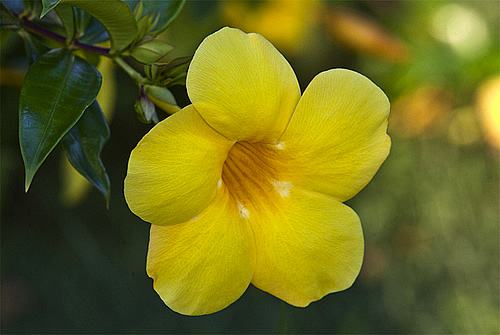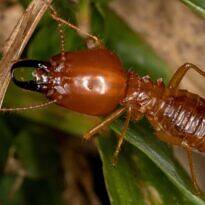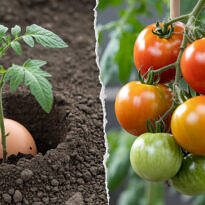
Question: I recently bought a young alamanda that I transplanted into a pot. It’s under direct sunlight on my balcony. About two days ago, I noticed that the leaves are losing their beautiful and characteristic shine. Could it be excessive watering?
Since it’s very hot here in Rio, I’ve been quite generous with watering. I prefer to water the plants at night. There doesn’t seem to be any pests present. I’d like to know what I can do to restore the shine to the leaves. Sincerely – Norma
Answer: Dear Norma, it’s normal for plants to experience stress after being transplanted, especially in such scorching summer weather. After all, the delicate fine roots can suffer damage, hindering the plant’s ability to absorb water efficiently. Additionally, the roots become a crucial focus for regeneration, consuming the plant’s energy. However, don’t worry, there are steps you can take to alleviate the stress and help your alamanda quickly pass through this challenging yet necessary phase. Follow these recommendations:
- Keep the plant in partial shade, receiving sun only in the morning or late afternoon.
- Continue watering generously in the evenings, but ensure proper drainage in the pot (avoid waterlogging).
- Hold off on fertilizing until the plant shows signs of new growth.
After around two weeks in partial shade, gradually reintroduce the plant to full sunlight. You’ll soon observe that it will regain its vitality and the characteristic shine that defines this species.
Understanding the Challenge: Post-Transplant Stress
The initial days after transplanting are pivotal, often bringing about stress for the plant. This stress is particularly pronounced in regions like Rio de Janeiro, where scorching summers prevail. The act of transplanting, while crucial for growth, disrupts the plant’s delicate root system. These fine roots play a pivotal role in water and nutrient absorption. As a result, the plant’s ability to flourish becomes compromised.
About the Golden Trumpet or Simply Allamanda
Adding a touch of exotic elegance to any setting, the Allamanda cathartica is a cherished flowering plant known for its enchanting trumpet-shaped yellow blooms. Native to the lush landscapes of South America, particularly Brazil, this plant has become a sought-after choice for both indoor and outdoor gardening enthusiasts. To ensure the flourishing growth and vitality of your recently acquired Allamanda, here’s a comprehensive guide that covers everything from planting to ongoing care.
- Selecting the Perfect Spot: Begin your Allamanda journey by choosing the ideal location. This plant thrives when basking in abundant sunlight, so opt for a site that receives at least 6 hours of direct sunlight daily. While sunlight is essential, be cautious of intense midday rays, particularly in hotter climates, as they may scorch the leaves.
- Planting Process: When it comes to planting, ensure you’ve prepared a well-draining soil mix enriched with organic matter. This mix should provide proper aeration and prevent waterlogging. If you’re growing your Allamanda in a container, select one with adequate drainage holes to prevent excess moisture buildup. Plant the Allamanda at the same depth as it was in its original container and gently firm the soil around the base.
- Temperature and Environmental Considerations: Maintaining the right temperature is crucial for Allamanda’s well-being. Aim to keep the temperature between 60°F and 85°F (15°C to 29°C) to mimic its native climate. Shield the plant from chilly drafts and frost, as Allamandas are sensitive to cold temperatures. Moreover, while they appreciate humidity, ensure proper ventilation to prevent the onset of fungal issues.
- Watering Wisdom: Balanced watering is key to a thriving Allamanda. Allow the top inch of the soil to dry out before watering, preventing both overhydration and drought stress. During active growth (spring and summer), water more frequently, adjusting based on your climate. In the resting phase (fall and winter), reduce watering, but don’t let the soil completely dry out. Always water at the base of the plant to avoid foliage wetness, which can lead to disease.
- Feeding for Flourishing: Support your Allamanda’s growth with regular fertilization. During the growing season, employ a balanced liquid fertilizer every 2-3 weeks. To encourage abundant flowering, opt for a fertilizer with a higher phosphorus content. As the dormant phase approaches, taper off fertilization to match the plant’s reduced growth.
- Pruning Pointers: Pruning is a vital aspect of Allamanda care. After the blooming season, engage in a light pruning session. Remove spent flowers and any dead or diseased branches to promote fresh growth and maintain the plant’s shape. Always wear protective gloves when pruning to avoid contact with the plant’s sap, which can cause skin and eye irritation.
- Vigilance Against Pests and Diseases: Allamandas, like all plants, can face pest and disease challenges. Regularly inspect the leaves and stems for signs of pests such as aphids, whiteflies, or spider mites. Should you spot any intruders, address them promptly with insecticidal soap or neem oil. Furthermore, be mindful of humid conditions that can encourage fungal growth, and ensure proper air circulation to prevent this.
- Nurturing Growth Through Support: As your Allamanda matures, it may require support to maintain an upright form. Consider adding a trellis or stakes to aid its vertical growth. Gently train the vines around the support structure to encourage a neat and visually pleasing appearance.
With these comprehensive guidelines, you’re well-equipped to embark on a successful Allamanda journey. From the initial planting stages to ongoing care and nurturing, you’ll be rewarded with the captivating beauty of golden trumpet blooms and lush green foliage that grace your surroundings with an irresistible allure.






